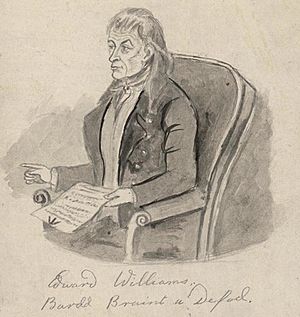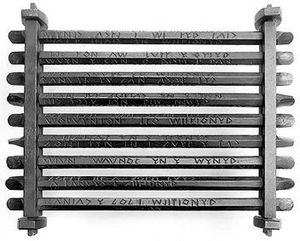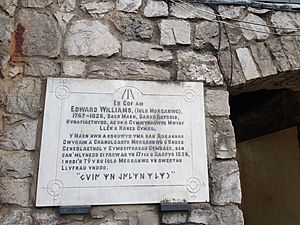Edward Williams facts for kids
Quick facts for kids
Iolo Morganwg
|
|
|---|---|

Drawing of Iolo Morganwg (c. 1800) by an unknown artist, in the National Library of Wales
|
|
| Born | Edward Williams 10 March 1747 Pen-onn, Vale of Glamorgan, Wales |
| Died | 18 December 1826 (aged 79) |
| Occupation | Stonemason, poet and collector |
| Language | Welsh |
| Nationality | Welsh |
Edward Williams, better known by his bardic name Iolo Morganwg, was a famous Welsh poet and collector. He lived from 1747 to 1826. He was thought to be an expert at finding old Welsh writings. However, after he died, people found out that he had made up, or forged, many of these old texts himself! Even so, he had a huge impact on Welsh culture. He started a group called the Gorsedd, which helped bring back the Eisteddfod festival in the 1700s. His ideas also greatly influenced neo-Druidism, a modern spiritual movement. His special bardic name, Iolo Morganwg, means "Iolo of Glamorgan" in Welsh.
Contents
Who Was Iolo Morganwg?
Early Life and Work
Edward Williams was born in a place called Pen-onn, near Llancarfan, in the Vale of Glamorgan, Wales. He grew up in the village of Flemingston. Just like his father, he became a stonemason, someone who works with stone.
In Glamorgan, he became very interested in collecting old handwritten books and papers. He also learned how to write Welsh poetry from local poets.
In 1773, he moved to London. There, he met other Welsh writers and became part of the Welsh literary community. He joined groups like the Gwyneddigion Society. In 1777, he returned to Wales, got married, and tried farming, but it didn't work out. Around this time, he started creating his first forgeries.
Iolo's son, Taliesin, was named after an ancient Welsh poet. Taliesin later gathered his father's many writings into 26 volumes. Some of these were published in 1848 as the Iolo Manuscripts.
His Literary Career
From a young age, Iolo wanted to protect and keep alive the old stories and traditions of Wales. He wrote many manuscripts, claiming they proved that ancient Druid traditions had survived through many challenges. These challenges included the Roman invasion, the spread of Christianity, and times when bards were treated badly by King Edward I.
His forged writings created a detailed, mystical way of thinking. He said this was a direct continuation of ancient Druid practices.
Iolo first became well-known in 1789 for a book called Barddoniaeth Dafydd ab Gwilym. This was a collection of poems by a famous 14th-century poet, Dafydd ap Gwilym. The book included many poems by Dafydd that no one had ever seen before. Today, these are believed to be Iolo's first forgeries.
His success led him back to London in 1791. There, he started the Gorsedd, a group of Welsh bards. He held the first ceremony on June 21, 1792, at Primrose Hill. He organized the event using what he claimed were ancient Druid rituals. In 1794, he published some of his own poems, which became quite popular. These poems are considered his only truly original works.
Iolo also worked with other scholars on The Myvyrian Archaiology of Wales. This was a three-volume collection of medieval Welsh literature published between 1801 and 1807. Some of the manuscripts used in this collection were from Iolo's own papers, and some of these were his forgeries. For example, he included a made-up history book and a book he said was written by Saint Cadoc. The second volume had a made-up "third series" of Welsh Triads, and he changed some of the real ones too.
After Iolo's death, his son Taliesin put together some of his writings into The Iolo Manuscripts. Many later scholars used his papers for their own studies. For instance, Lady Charlotte Guest used them when she translated the famous Welsh stories known as the Mabinogion. Later, more of Iolo's forgeries were published in a book called Barddas. This book, published in 1862 and 1874, claimed to be a translation of works by Llywelyn Siôn. It described the history of the Welsh bardic system from ancient times. While it doesn't contain real Druid knowledge, it gives the fullest picture of the mystical ideas Iolo created.
Other works by Iolo include the "Druid's Prayer", which is still used by the Gorsedd and modern Druid groups. He also wrote a book on Welsh poetry rules called Cyfrinach Beirdd Ynys Prydain ("The Mystery of the Bards of the Isle of Britain"), published after he died in 1828. In 1812, he published a series of hymns called Salmau yr Eglwys yn yr Anialwch ("Psalms of the church in the wilderness").
Iolo's Ideas
Iolo's ideas combined influences from Christianity and Arthurian legend. He also loved the romantic style of writers like William Blake and the Scottish poet James Macpherson. He was very enthusiastic about all things "Celtic" and included parts of real Welsh bardic traditions that had survived.
One of his goals was to show that South Wales, especially his home region of Glamorgan, was just as important to Welsh traditions as North Wales. His forged writings and other works explained a theory of different "rings of existence." These rings went outwards from Annwn (the Otherworld) through Abred and Ceugant to Gwynfyd (a state of purity or Heaven).
Outside his shop in Cowbridge, Iolo had a sign saying his sugar came from farms that did not use enslaved people.
By 1799, he became a Unitarian, a type of Christian belief. He was a key leader when a Unitarian group was formed in South Wales in 1802. He wrote their rules and procedures, published in 1803.
The Bardic Alphabet
Iolo Morganwg created his own special writing system, which he called Coelbren y Beirdd ("the Bardic Alphabet"). He claimed it was the ancient writing system of the Druids. It had 20 main letters and 20 more for special sounds. These symbols were meant to be carved onto a wooden frame called a peithynen.
Was He a Forger?
Finding the Truth
Towards the end of the 1800s, a language expert named Sir John Morris-Jones helped show that Iolo was a forger. This led to Iolo being called a "charlatan," meaning someone who pretends to have special knowledge. Morris-Jones said Iolo was "hateful" and that it would take a long time for Welsh history and literature to be free of his "dirty fingers."
After the First World War, a scholar named Griffith John Williams (1892–1963) was the first to study all of Iolo's work in detail. He looked at the original documents that Iolo's family had given to the National Library of Wales in 1917. Williams wanted to find out exactly how much of Iolo's writings were made up and how much was real. He proved that the poems Iolo said were by Dafydd ap Gwilym were actually forgeries. His research made him both a critic and a defender of Iolo's importance.
Some people have suggested that a few of Iolo's claims might have been based on old stories passed down by word of mouth. For example, recent research suggests that the tale of Ieuan Gethin, a soldier in the Glyndŵr revolt, might have some truth to it.
His Lasting Impact
Iolo's forgeries were so widespread that even today, some of his changed versions of medieval Welsh texts are better known than the original, real versions.
A Welsh-language school in Cowbridge, Ysgol Iolo Morganwg, is named after him. Also, Gruff Rhys, the singer from the band Super Furry Animals, dedicated a song to Iolo on his 2014 album, American Interior.
A Selection of Iolo Morganwg's Manuscripts
See also
- Geraint the Blue Bard
- List of 18th-century British working-class writers







